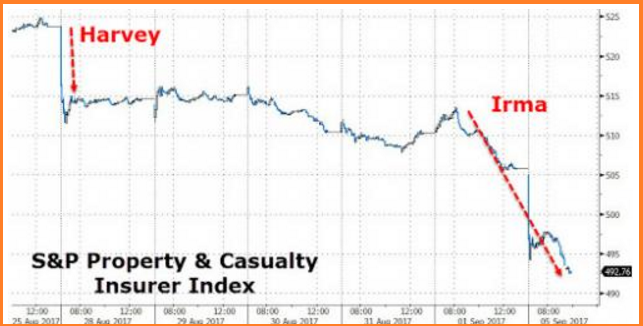With winds topping 180 mph, Category 5 Hurricane Irma has been deemed the strongest Atlantic hurricane on record – which, writes Barclays, could hit southern Florida early next week. Evacuation orders have been issued to the Keys.
Hurricane #Irma now a category 5 and it's a beast. It's larger than the state of Ohio, if that helps put it in perspective. pic.twitter.com/JtoZNlONeE
— ⚡JD Rudd – News5 (@jdrudd) September 5, 2017
“We think Irma’s insured damage in Florida could be the largest ever in the US perhaps equivalent to Hurricane Katrina in 2005 ($50bn on an inflation-adjusted basis). In a worst case scenario, catastrophe modelers AIR Worldwide and Karen Clark and Co. have estimated a repeat of the 1926 Miami hurricane could result in $125-130bn of insured damage.”
Hurricane #Irma is so strong it's starting to show up on seismometers in the Caribbean — equipment designed to measure earthquakes. pic.twitter.com/9S5LxmtGeT
— Kissimmee Utility (@KUAdirect) September 5, 2017
This is substantially higher than the mostly uninsured property affected in Texas by hurricane Harvey, and has sent the S&P Property & Casualty Insurer Index tumbling.

Via CNBC:
Stock prices of home insurers tied to Florida plunged Tuesday after Irma strengthened into a Category 5 storm. This latest storm system follows Harvey, which dumped several feet of rain, destroyed thousands of homes and killed over 50 people in a matter of days.
Shares of HCI Group, Universal Insurance Holdings, and Heritage Insurance Holdings, which provide property and casualty homeowners insurance in the Sunshine State, were down 13, 16, and 13 percent, respectively.
Barclay’s Jay Gelb writes:
“We would view Irma as more of a risk to the traditional reinsurers as well as third-party providers of reinsurance capital than the primary commercial insurers and personal lines insurers based on the industry’s long-standing view that Florida poses substantial windstorm risk. Of the companies we cover, reinsurers expected to have among the largest exposures to a Florida hurricane could include RE, XL, VR, RNR, and AHL. Among primary commercial insurers, we would expect AIG to have among the largest exposure.”
- As publicly disclosed at the time, UPCIC has a net retention of $35 million per catastrophe event for losses incurred, in all states, up to a first event loss of $2.65 billion. In addition, under an excess catastrophe contract specifically covering risks located outside the state of Florida and intended to further reduce UPCIC’s $35 million net retention, UPCIC has obtained catastrophe coverage of $30 million in excess of $5 million covering certain loss occurrences, including hurricanes, in states outside of Florida.
- In certain circumstances involving a catastrophic event impacting both Florida and other states, UPCIC’s retention could result in pre-tax net liability as low as $5 million — the $35 million net retention under the all states reinsurance program could be offset by as much as $30 million in coverage under the other states reinsurance program. These retention amounts are gross of any potential tax benefit the Company would receive in paying such losses. UPCIC’s statutory surplus as of June 30, 2017 was $351 million.
Anyone in Florida or in the path of Hurricane Irma PLEASE watch this video of how to deal W/ a cat5 hurricane #Irma pic.twitter.com/88q9yVMRWd
— Drew Liquerman ?? (@DrewLiquerman) September 5, 2017
To top it off, gulf residents will be dealing with Jose next…
If you enjoy the content at iBankCoin, please follow us on Twitter





Climate change is a chinese hoax. These hurricanes are made up events to make you believe in fake science and tax you later. buy guns!
Shares of HCI Group, Universal Insurance Holdings, and Heritage Insurance Holdings, which provide property and casualty homeowners insurance in the Sunshine State, were down 13, 16, and 13 percent, respectively.
That’s opportunity. A bit too small cap for me, but opportunity non the less
I wonder if increased hurricane activity has anything to do with the cosmic ray cycle, which is inverse more or less to the solar cycle. This is the strongest cosmic ray cycle in a few hundred years. Check Svensmark’s work on this https://youtu.be/yZ7IEUBUe4s
How are we gonna pay for the wall with all these hurricanes? Second term item seems at this point